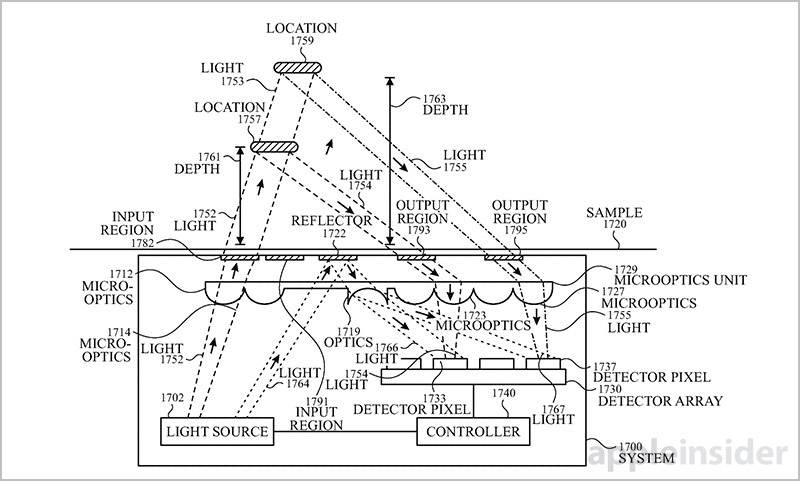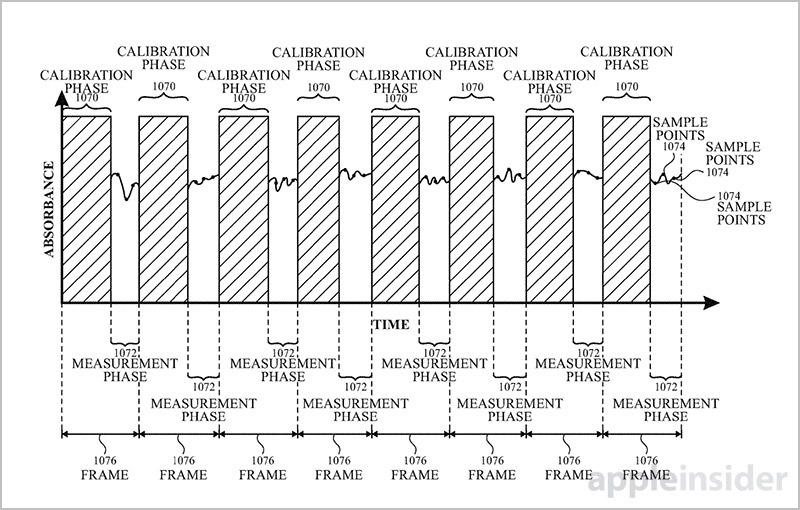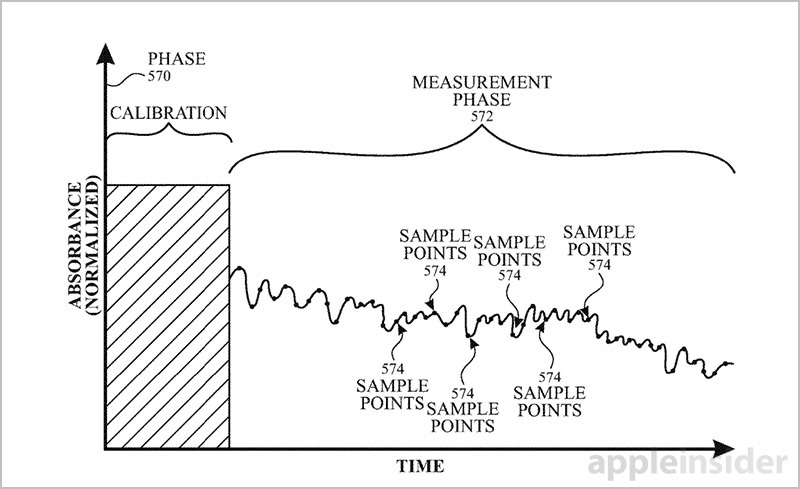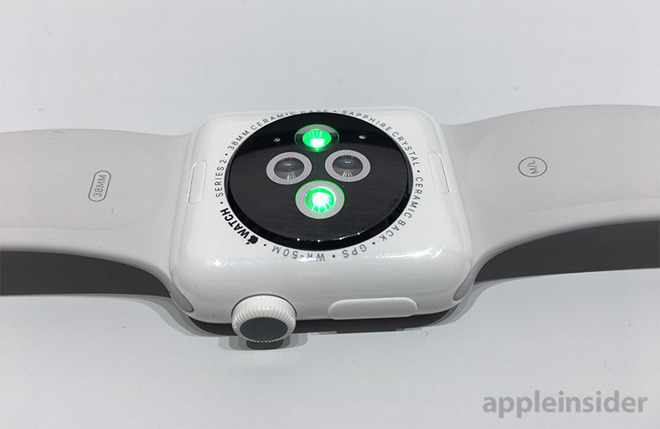A patent application published Thursday potentially offers clues into Apple's rumored non-invasive glucose monitoring solution, diabetes tracking technology considered to be a "holy grail" of medical science.
Published by the U.S. Patent and Trademark Office on Thursday, Apple's patent application for "Reference switch architectures for noncontact sensing of substances" details methods by which an electronic device can be calibrated to measure the concentration of a particular substance in a given sample.
More specifically, an optical system is configured to perform absorption spectroscopy. The technique enables determination of the concentration of a target substance by applying light with known properties, like wavelength and energy, to a sample. As light passes through the sample, the substance absorbs energy at certain wavelengths, causing the light's properties to change upon exit.
Comparing light transmitted through the sample with reference light allows a exemplary system to detect measured absorbance, such as a loss in intensity. As the concentration of a substance within a sample increases, so does the amount of energy that can be absorbed.
Further, substances display "absorbance peaks," or differences in their ability to absorb light at specific wavelengths, meaning they each have a unique signature when light of a known value is applied. This is known as a spectral fingerprint.
As Apple notes, the technique has limitations. For example, a given sample might contain multiple substances or spectral artifacts, some of which can obscure or otherwise degrade detection of a substance of interest. Additionally, a substance might not be equally distributed throughout a sample.
In particular, the application identifies fluctuations, drifts and variations that could cause accuracy issues.
Apple's invention aims to rectify some of those issues. Among a host of refinements, the application details an apparatus that incorporates specialized light emitters, filters, beamsplitters, short-wavelength infrared (SWIR) detectors and other components to compensate for potential inaccuracies caused by unknown factors.
Beam-splitters are used to create multiple light paths in one example. One path is routed to a sample while another is directed to one of two matched detectors and used as a reference for comparison, thereby reducing error. Another embodiment uses a common detector to further ameliorate inconsistent readings resulting from mismatched components or responses to environmental conditions.
Other methods involve the use of multiple microoptics disposed over discrete detector pixels. These systems measure properties of light reflected off the surface of a sample, such as reflectivity, refractive index, density, concentration, scattering coefficient, scattering anisotropy, absorption and more to determine the concentration of a substance therein.
Apple also mentions techniques of constantly calibrating the system to maintain a high degree of accuracy.
While the document does not specify what substances might be measured by the proposed system, it does note the sample can "include at a least a portion of a user." The application jibes with rumors that Apple is working on a non-invasive glucose monitoring solution for use in Apple Watch.
Tracking glucose, a relatively small molecule, in a user's bloodstream using light-based detection techniques limits Apple's options. Existing scientific methods of identifying the makeup of sample material rely on SWIR and mid-wavelength infrared (MWIR), as explained in Apple's filing. The technology has not been successfully applied to glucose monitoring, though a number of researchers are attempting to find a solution with a related technique called Raman spectroscopy.
Unlike absorption spectroscopy, Raman spectroscopy, named after physicist C.V. Raman, emits light at a sample and measures the scattered light. A small portion of scattered light shifts in energy due to interactions between the light and vibrational energy levels of a sample. A plot of the shifted light results in a Raman spectrum that can be used to identify the molecular fingerprint, and thereby molecules, of an evaluated substance.
One firm attempting to work Raman spectroscopy into a shipping product was C8 MediSensors. In 2014, MIT Technology Review profiled the now defunct company, noting it attempted to use the technique in a smartphone-connected device that measured glucose levels through the skin.
Though it showed initial promise, raising more than $60 million from the likes of GE Capital and GE Healthcare, C8 ultimately failed to produce a working product. The firm was unable to overcome technical hurdles like user variability, the report said.
Apple reportedly picked up former employees of C8 as part of a 2013 hiring spree. It is perhaps no coincidence that today's patent application covers methods of collecting and measuring scattered light, even though it fails to mention Raman spectroscopy by name.
Rumors of an Apple-developed blood sugar monitoring solution began to circulate last year, when reports suggested the company was working on non-invasive technology as a complement to Apple Watch. CEO Tim Cook was at one point said to be personally testing a prototype of such a device.
Tangible evidence of Apple's interest in the technology arrived in the form of a patent infringement lawsuit filed earlier this year by health technology startup Omni MedSci. Omni's founder and CTO, Dr. Mohammed N. Islam, claims Apple approached him in 2014 to discuss his IP covering hardware designed to measure various parameters of a user's blood with LED-based sensors.
Islam contends Apple Watch's heart rate sensor infringes on his patents, claims that are dubious at best. Apple presented Apple Watch and its custom sensor three months after company representatives allegedly met with the inventor, suggesting the technology was finalized months or years prior.
Islam and Apple conducted multiple meetings and continued to correspond with high-ranking executives including VP of product marketing Greg Joswiak until 2016, two years after Apple Watch debuted.
More interesting than Islam's allegations, however, is an asserted patent that covers non-invasive methods of monitoring glucose levels in a patient's blood.
Apple's patent application was first filed for in August 2015 and credits Miikka M. Kangas, Mark Alan Arbore, David I. Simon, Michael J. Bishop, James W. Hillendahl and Robert Chen as its inventors.
 Mikey Campbell
Mikey Campbell










-m.jpg)






 Christine McKee
Christine McKee
 Andrew Orr
Andrew Orr
 Andrew O'Hara
Andrew O'Hara
 William Gallagher
William Gallagher

 Mike Wuerthele
Mike Wuerthele
 Bon Adamson
Bon Adamson
 Marko Zivkovic
Marko Zivkovic




-m.jpg)



59 Comments
This would be a literally life changing advance if it can be made reliable. Something that has so far resisted all attempts to crack this particular nut.
Reliable non-invasive constant glucose monitoring would be Nobel worthy.
Soon to countless Apple Watch copycats: Apple, Alphabet's R&D division .....
Reliability is key if we are to trust the readings. So far, the AW heart rate monitor hasn't proven to be reliable enough for me and that should be relatively simple.
Is there any possibility this will be in the AW4, or is it too early?
Apple is working on this holly grail for long. And failed several times. When they succeed then as somebody said will "sell a helluva lot of watches!" And it will be hard to copycat that. Also because ReseachKit and other software connected to it.
I’m skeptical Apple will be the first to bring this to market. Wouldn’t it need FDA approval? Seems to me it would start in the medical devices community and once proven to work Apple could bring it to the masses.